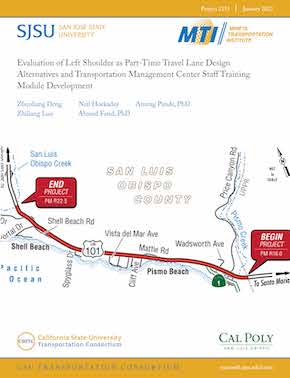- 408-924-7560
- mineta-institute@sjsu.edu
- Donate
Evaluation of Left Shoulder as Part-Time Travel Lane Design Alternatives and Transportation Management Center Staff Training Module Development
Permanent capacity expansion, such as adding new lanes, is no longer a viable strategy to address traffic congestion in California; hence, ITS (Intelligent Transportation System) strategies, such as part-time use of the shoulder as a travel lane, need to be explored. The use of the shoulder as a travel lane during peak traffic hours has limited applications in the US, and most use the right shoulder as a part-time travel lane even though either the right or left shoulder (but not both) may be used. Caltrans District 5 is exploring the use of Left Shoulder as a Part-time Travel Lane (LSPTTL) as a piece of the larger project, titled Five Cities Multimodal Transportation Network Enhancement Project (FCMTNEP), aimed at congestion relief near Pismo Beach, CA. Construction is expected to begin in Winter 2025 with a Winter 2027 completion date. Given that this would be the first instance of LSPTTL in California, it is a Project of Division Interest (PoDI) for the California division of Federal Highway Administration (FHWA), and the District 5 experience may guide similar future installations of the shoulder as travel lane projects in the state. This research uses a microsimulation-based approach to evaluate design alternatives being explored by Caltrans District 5. This approach allows for evaluating the operational and safety effects of each of the alternatives. Furthermore, a Transportation Management Center (TMC) operator training framework has also been developed to ensure that the local TMC personnel can effectively deploy the LSPTTL during routine operations and emergencies. Based on the operational evaluation, the study found no significant difference in travel times associated with the three design alternatives. Alternative 2, which involves the longest segment with LSPTTL among the alternatives, was found to be the safest based on a surrogate safety measure-based evaluation. This framework for evaluating design alternatives for operations and safety effectiveness may be used for future projects that involve the use of the shoulder as a travel lane. For TMC operator training, this report documents key learning objectives. A hands-on training program that involves operators executing the opening and closing of the shoulder for routine and emergency conditions was developed. As the project nears implementation, there is some scope for improvement in the training modules through replication of the exact features of the LSPTTL design and introducing more realism in the TMC simulator training exercises.
ANURAG PANDE, PHD
Dr. Anurag Pande is a Professor of Civil Engineering at California Polytechnic State University (Cal Poly). His research interests include traffic simulation, data mining applications, and observational data analysis, including the areas of traffic safety and crashes, driver behavior, transportation resilience, and emergency evacuation.
NEIL HOCKADAY
Mr. Neil Hockaday is Research Associate at Cal Poly. He has played a key role in TMC simulation planning and implementation of the training capabilities in the previous UCI (University of California Irvine) facility, as well as the current iteration of the TMC academy at Cal Poly.
AHMED FARID, PHD
Dr. Farid is a Postdoctoral Fellow in the department of Civil Engineering at Cal Poly. His research interests include traffic safety, data mining applications, and observational data analysis, including the areas of traffic safety and crashes.
ZHUOHANG DENG
Mr. Deng is a graduate student in the department of Civil Engineering at Cal Poly.
ZHILIANG LUO
Mr. Zhilinag Luo is a graduate student in the department of Civil Engineering at Cal Poly.
-
Contact Us
San José State University One Washington Square, San Jose, CA 95192 Phone: 408-924-7560 Email: mineta-institute@sjsu.edu






